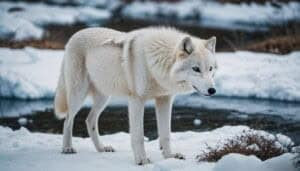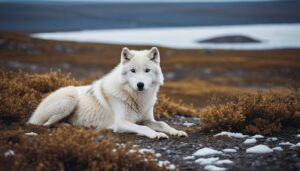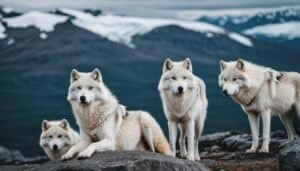Introduction
The Arctic wolf, also known as the white wolf or polar wolf, roams the harsh tundra of the Arctic regions. These resilient animals form close-knit packs that navigate and survive in one of the most extreme environments on Earth
This article explores the typical range size of an Arctic wolf pack, the factors influencing their territory, their adaptations and survival strategies, and the challenges they face in their natural habitat. Discover the fascinating dynamics of Arctic wolf packs and how they maintain their territory in the wild
Typical Range Size of an Arctic Wolf Pack
The typical range size for an Arctic wolf pack in their habitat spans from 1,000 to 3,000 square miles (2,600 to 7,800 square kilometers), varying based on factors such as prey availability, environmental conditions, and pack size. An Arctic wolf pack typically consists of about 5 to 10 wolves
Arctic wolves are highly adapted to the extreme conditions of their environment, and their range size is influenced by various factors. Understanding these elements helps to shed light on how these remarkable animals survive and thrive in the harsh Arctic tundra
Factors Influencing Range Size
The range size of an Arctic wolf pack can vary significantly based on several factors. One primary factor is the availability of prey
In regions where prey is abundant, packs tend to have smaller ranges since their food sources are easily accessible. Conversely, in areas where prey is scarce, packs need to cover larger territories to find enough food to sustain themselves
Another critical factor is the season. During the winter months, prey animals such as caribou and musk oxen migrate, forcing Arctic wolf packs to travel greater distances to hunt. In the summer, when prey is more stationary, the wolves’ range can shrink as food becomes more readily available
Human activity and environmental changes also play a role in determining the range size. Areas with increased human presence or industrial activity may push wolf packs to more remote regions, often expanding their range. Climate change, affecting the distribution and availability of prey, can also lead to changes in the range size
Territory Establishment and Maintenance
Arctic wolves establish and maintain their territories through a combination of scent marking and vocalizations. Scent marking involves the use of urine and feces to delineate the boundaries of their range, signaling to other wolves that the area is occupied. This helps to reduce conflicts with neighboring packs and maintain the stability of their territory
Vocalizations, such as howling, play a crucial role in territory maintenance. Howling serves multiple purposes: it communicates the presence of the pack to other wolves, coordinates activities within the pack, and helps to locate pack members over vast distances. This vocal behavior is especially important in the expansive and often visually obstructed Arctic landscape
Territorial disputes do occur, and they can result in aggressive encounters. However, such conflicts are relatively rare, as wolves prefer to avoid direct confrontations that can lead to injuries
Average Number of Wolves in a Pack
The size of an Arctic wolf pack typically ranges from five to ten members, although packs as large as twenty have been observed. The composition of the pack usually includes a dominant breeding pair, their offspring, and occasionally other adult wolves who help with hunting and care of the young
Pack size can fluctuate based on several factors, including the availability of food and the time of year. During the breeding season, packs tend to be larger as pups are born and raised
In contrast, during harsher conditions or periods of food scarcity, pack sizes may decrease as some members disperse to form new packs or search for better resources
Seasonal Variations in Range Size
Seasonal changes significantly impact the range size of Arctic wolf packs. In winter, when food is scarce and prey migrates, packs must cover larger areas to find sufficient food
This often leads to increased mobility and expanded ranges. The harsh weather and snow cover also affect their ability to travel and hunt, necessitating more extensive ranges
During the summer, the conditions are less severe, and prey is more concentrated in certain areas. This allows the packs to reduce their range size and stay closer to abundant food sources. The summer season also provides an opportunity for the wolves to raise their young, requiring a more stable and defined territory to ensure the safety and development of the pups
Adaptations and Survival Strategies of Arctic Wolves
Arctic wolves have evolved numerous adaptations and survival strategies to thrive in the extreme conditions of the Arctic tundra. These adaptations not only help them withstand the harsh climate but also enable them to efficiently hunt and navigate their vast territories
Environmental Adaptations
Arctic wolves are well-equipped to handle the cold, icy environment they inhabit. One of their most notable adaptations is their thick, double-layered coat. The outer layer of fur is long and water-resistant, while the dense undercoat provides insulation against the frigid temperatures. This dual-layered coat helps the wolves maintain body heat even in sub-zero conditions
Their physical build is also adapted to the snowy terrain. Arctic wolves have shorter ears and snouts compared to other wolf subspecies, which minimizes heat loss
Their paws are large and well-padded, distributing their weight more evenly as they walk on snow and ice, and are covered with fur to provide extra warmth and traction
Moreover, their keen sense of hearing and smell is crucial for detecting prey and navigating the vast, often featureless landscape. These heightened senses enable them to locate prey from great distances, even when visibility is poor due to snowstorms or the polar night
Hunting and Prey Species
Arctic wolves are opportunistic hunters with a diet primarily consisting of large herbivores such as caribou and musk oxen
These prey species are well-adapted to the Arctic environment and provide substantial nourishment for the wolves. Hunting large prey requires coordinated efforts and teamwork within the pack, highlighting the importance of their social structure
In addition to large herbivores, Arctic wolves also hunt smaller animals like Arctic hares, lemmings, and birds. These smaller prey items are especially important during periods when larger prey is scarce or difficult to hunt
The wolves’ hunting strategies vary based on the prey they target. For larger animals, they often rely on endurance hunting, where they track and exhaust their prey over long distances. For smaller, quicker animals, they use stealth and sudden bursts of speed to capture them
Role of the Alpha Wolf
The alpha wolf plays a crucial role in the pack’s survival and social dynamics. Typically, the alpha pair consists of the dominant male and female, who are usually the only wolves in the pack that breed. They lead the pack during hunts, make decisions regarding movement and territory, and mediate conflicts within the group
The alpha wolves’ leadership ensures the pack operates efficiently, especially during hunts and when defending their territory. Their experience and knowledge are vital in making strategic decisions that impact the pack’s survival, such as identifying optimal hunting grounds and avoiding potential dangers
The alpha wolves also play a significant role in raising the pups, teaching them essential survival skills and social behaviors. This mentorship is critical for the young wolves’ development and integration into the pack’s social structure
Challenges Faced by Arctic Wolf Packs
Despite their remarkable adaptations, Arctic wolf packs face numerous challenges in their harsh and changing environment. These challenges impact their survival and can lead to significant changes in their behavior and territory
Climate and Seasonal Changes
Climate and seasonal changes are some of the most significant challenges Arctic wolves face. The Arctic tundra experiences extreme weather conditions, with temperatures plummeting well below freezing during the winter months. This harsh climate affects the availability of prey and the wolves’ ability to hunt
In winter, heavy snowfall and ice make it difficult for wolves to track and capture prey. The migration patterns of their primary prey species, such as caribou, also mean that wolves must travel long distances to find food. This increases their energy expenditure and can lead to starvation if food is scarce
The summer months bring their own set of challenges. While prey is more abundant, the melting ice and snow can lead to flooding, making certain areas impassable. Additionally, the warming climate due to global climate change is altering the habitat and behavior of prey species, forcing wolves to adapt to these rapid changes
Human Impact and Conservation Efforts
Human activities pose a growing threat to Arctic wolf populations. Industrial activities such as mining, oil exploration, and road construction disrupt the wolves’ natural habitat and migration routes. These activities can lead to habitat fragmentation, making it more difficult for wolves to find food and maintain their territories
Additionally, increased human presence in the Arctic, whether for research, tourism, or resource extraction, can lead to direct conflicts with wolves. This includes accidental shootings, vehicle collisions, and the disruption of den sites
As human activity in the Arctic continues to grow, so does the potential for negative interactions between humans and wolves
Conservation efforts are critical in addressing these challenges and ensuring the survival of Arctic wolf populations. These efforts include creating protected areas where industrial activities are limited or prohibited, monitoring wolf populations to gather data on their health and numbers, and implementing policies that minimize human-wildlife conflicts
International cooperation is also essential, as Arctic wolves roam across national borders. Collaborative conservation initiatives can help to establish comprehensive strategies for protecting these wolves and their habitat
Conclusion
Arctic wolves are extraordinary creatures, uniquely adapted to survive in one of the planet’s harshest environments. The typical range size of an Arctic wolf pack varies based on several factors, including prey availability, seasonal changes, and human impact
These packs maintain their territories through scent marking and vocalizations, with the alpha wolves playing a crucial role in leadership and survival strategies. Their adaptations, such as a thick fur coat and efficient hunting techniques, enable them to thrive in the Arctic tundra
However, Arctic wolf packs face significant challenges, from extreme climate conditions to human activities that disrupt their habitat. Conservation efforts are essential to mitigate these impacts and ensure the long-term survival of Arctic wolf populations
By understanding the dynamics of Arctic wolf packs and addressing the challenges they face, we can better appreciate and protect these remarkable animals and their fragile Arctic ecosystem










